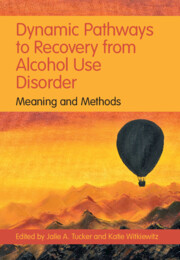Book contents
- Dynamic Pathways to Recovery from Alcohol Use Disorder
- Dynamic Pathways to Recovery from Alcohol Use Disorder
- Copyright page
- Dedication
- Contents
- Figures
- Tables
- Contributors
- Foreword
- Preface
- Acknowledgments
- Introduction
- Part I Micro Level
- 2 Biopsychosocial Process of Change in Alcohol Use Disorder Recovery
- 3 The Role of Self-Regulation Strategies in Recovery from Alcohol Use Disorder
- 4 Neuropsychological and Biological Influences on Drinking Behavior Change
- 5 Lifespan Developmental Perspectives on Natural Mechanisms of Cessation of Risky Alcohol Use and Recovery from Alcohol Use Disorder
- 6 Mutual Help Approaches and Mechanisms of Change
- 7 Time-Varying Effect Modeling to Examine Recovery Outcomes across Four Years
- 8 Latent Variable Mixture Modeling Approaches to Investigating Longitudinal Recovery Processes
- Part II Meso Level
- Part III Macro Level
- Conclusions and Future Directions
- Index
- References
4 - Neuropsychological and Biological Influences on Drinking Behavior Change
from Part I - Micro Level
Published online by Cambridge University Press: 23 December 2021
- Dynamic Pathways to Recovery from Alcohol Use Disorder
- Dynamic Pathways to Recovery from Alcohol Use Disorder
- Copyright page
- Dedication
- Contents
- Figures
- Tables
- Contributors
- Foreword
- Preface
- Acknowledgments
- Introduction
- Part I Micro Level
- 2 Biopsychosocial Process of Change in Alcohol Use Disorder Recovery
- 3 The Role of Self-Regulation Strategies in Recovery from Alcohol Use Disorder
- 4 Neuropsychological and Biological Influences on Drinking Behavior Change
- 5 Lifespan Developmental Perspectives on Natural Mechanisms of Cessation of Risky Alcohol Use and Recovery from Alcohol Use Disorder
- 6 Mutual Help Approaches and Mechanisms of Change
- 7 Time-Varying Effect Modeling to Examine Recovery Outcomes across Four Years
- 8 Latent Variable Mixture Modeling Approaches to Investigating Longitudinal Recovery Processes
- Part II Meso Level
- Part III Macro Level
- Conclusions and Future Directions
- Index
- References
Summary
An individual’s recovery from alcohol use disorder (AUD) occurs within the context of changes in drinking behavior as well as changes in physical and mental health. This chapter considers how drinking behavior change can arise from, and be supported by, functional improvements in the brain and in peripheral organ systems. The chapter proposes that arousal serves as a common process that can either support or hinder recovery through its link to executive control, negative emotionality, and cue salience; arousal is measurable through overt human behavior, physiological reactivity, and neural activation; and arousal modulation may serve as a holistic intervention target to help sustain recovery. The chapter considers how the arousal construct may be used to identify more homogeneous subgroups of persons in recovery, such as those who may benefit from arousal-modulation adjuvants to bolster executive cognitive control, affect regulation, and flexible responses to contextual cues.
Keywords
- Type
- Chapter
- Information
- Dynamic Pathways to Recovery from Alcohol Use DisorderMeaning and Methods, pp. 60 - 76Publisher: Cambridge University PressPrint publication year: 2022
References
- 1
- Cited by



